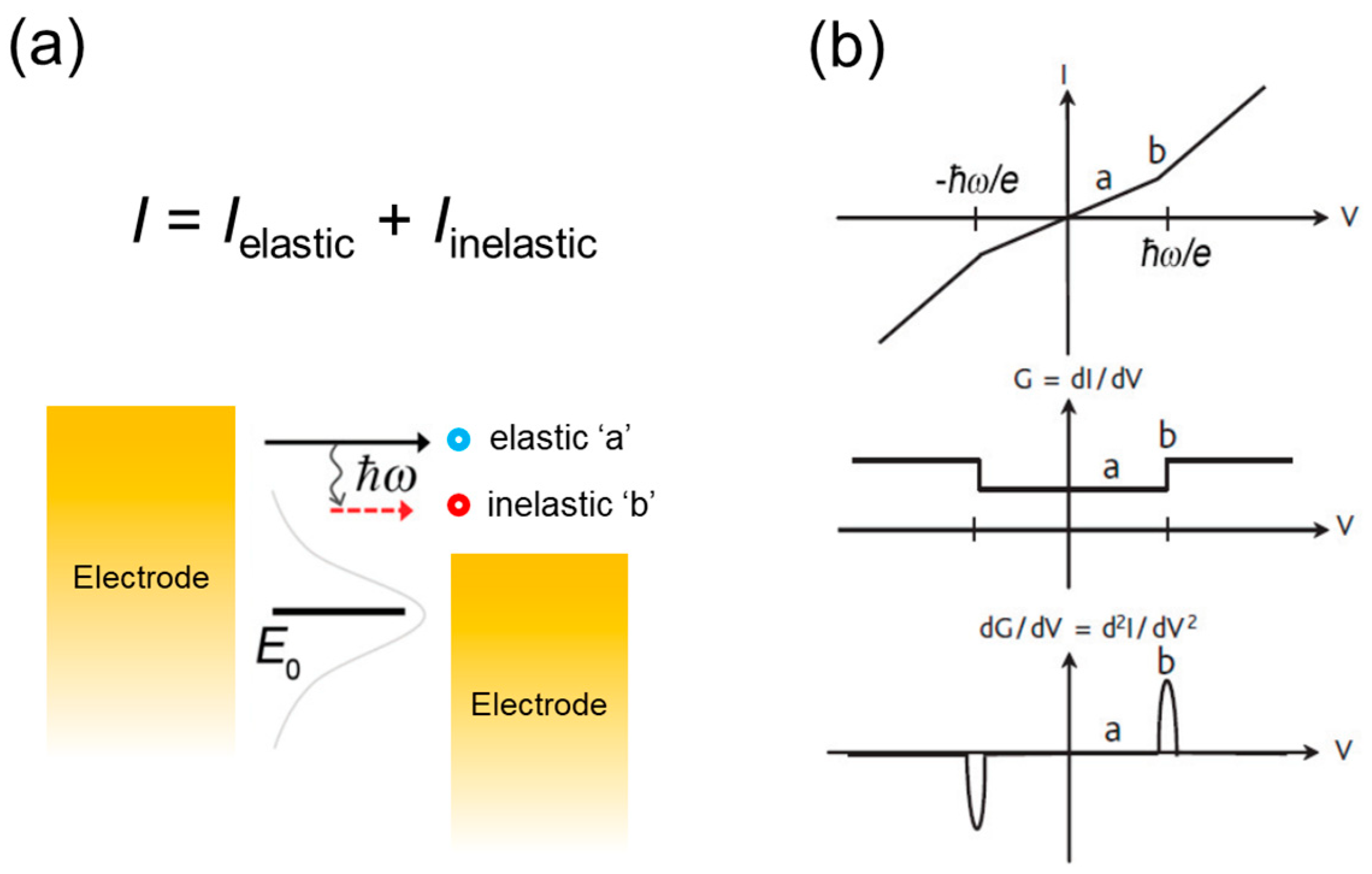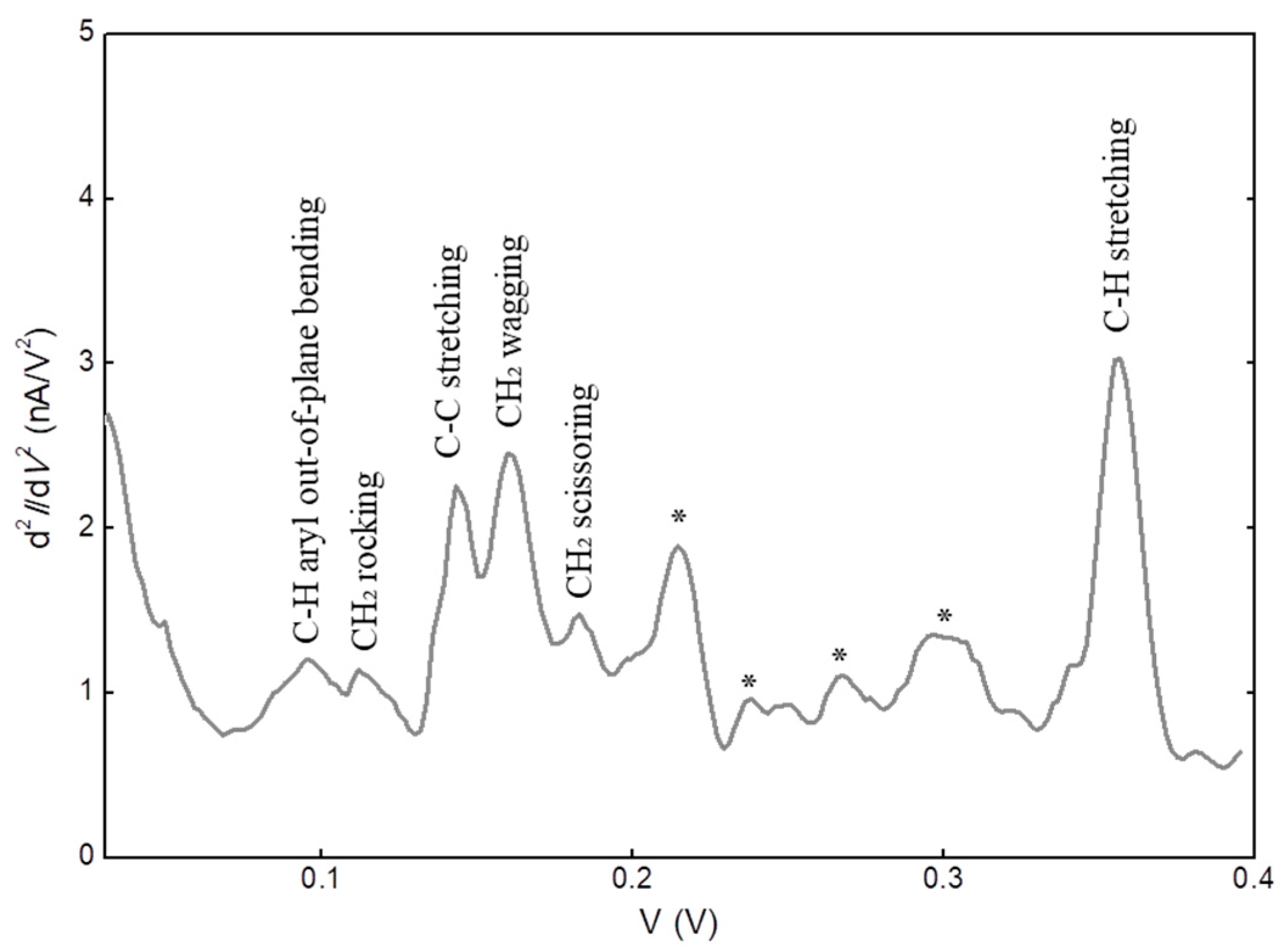Inelastic Electron Tunneling Spectroscopy of Aryl Alkane Molecular Junction Devices with Graphene Electrodes
Abstract
1. Introduction
2. Materials and Methods
3. Results and Discussion
3.1. Elecrical Tranpsort Characterizations
3.2. Inelastic Electron-Tunneling Spectroscopy Measurements
3.3. Broadeing of Spectral Linewidths
4. Conclusions
Supplementary Materials
Funding
Data Availability Statement
Conflicts of Interest
References
- Vilan, A.; Aswal, D.; Cahen, D. Large-Area, Ensemble molecular electronics: Motivation and challenges. Chem. Rev. 2017, 117, 4248–4286. [Google Scholar] [CrossRef] [PubMed]
- Yuan, M.; Qiu, Y.; Gao, H.; Feng, J.; Jiang, L.; Wu, Y. Molecular electronics: From nanostructure assembly to device integration. J. Am. Chem. Soc. 2024, 146, 7885–7904. [Google Scholar] [CrossRef]
- Yu, C.J.; Von Kugelgen, S.; Laorenza, D.W.; Freedman, D.E. A molecular approach to quantum sensing. ACS Cent. Sci. 2021, 7, 712–723. [Google Scholar] [CrossRef]
- Moreno-Pineda, E.; Wernsdorfer, W. Measuring molecular magnets for quantum technologies. Nat. Rev. Phys. 2021, 3, 645–659. [Google Scholar] [CrossRef]
- Chen, H.; Fraser Stoddart, J. From molecular to supramolecular electronics. Nat. Rev. Mater. 2021, 6, 804–828. [Google Scholar] [CrossRef]
- Al-Owaedi, O.A.; Najeeb, H.N.; Aldulaimi, A.K.O.; Alwan, N.H.; Ali, M.S.; Dwech, M.H.; AL-Da’amy, M.A. Thermoelectric signature of d-orbitals in tripod-based molecular junctions. Mater. Adv. 2024, 5, 9781–9791. [Google Scholar] [CrossRef]
- Jia, C.; Guo, X. Molecule–electrode interfaces in molecular electronic devices. Chem. Soc. Rev. 2013, 42, 5642–5660. [Google Scholar] [CrossRef]
- McCreery, R.L.; Bergren, A.J. Progress with molecular electronic junctions: Meeting experimental challenges in design and fabrication. Adv. Mater. 2009, 21, 4303–4322. [Google Scholar] [CrossRef] [PubMed]
- Wan, A.; Jiang, L.; Sangeeth, C.S.S.; Nijhuis, C.A. Reversible soft top-contacts to yield molecular junctions with precise and reproducible electrical characteristics. Adv. Funct. Mater. 2014, 24, 4442–4456. [Google Scholar] [CrossRef]
- Li, T.; Bandari, V.K.; Schmidt, O.G. Molecular electronics: Creating and bridging molecular junctions and promoting its commercialization. Adv. Mater. 2023, 35, 2209088. [Google Scholar] [CrossRef]
- Kim, Y.; Chang, S.W. Inelastic electron tunneling spectroscopy: Investigation of bulk dielectrics and molecules. IEEE Trans. Electron Devices 2021, 68, 1411–1419. [Google Scholar] [CrossRef]
- Ngabonziza, P.; Wang, Y.; van Aken, P.A.; Maier, J.; Mannhart, J. Inelastic electron tunneling spectroscopy at high-temperatures. Adv. Mater. 2021, 33, 2007299. [Google Scholar] [CrossRef] [PubMed]
- Cao, Y.; Austin, D.; Switzer, E.D.; Rowen, J.F.; Sander, W.; Rahman, T.S.; Morgenstern, K. Inelastic electron tunneling spectroscopy as a probe of electronic coupling at a molecule-metal interface. Phys. Rev. B 2025, 111, 115426. [Google Scholar] [CrossRef]
- Jeong, H.; Kim, D.; Kwon, H.; Hwang, W.-T.; Jang, Y.; Min, M.; Char, K.; Xiang, D.; Jeong, H.; Lee, T. Statistical investigation of the length-dependent deviations in the electrical characteristics of molecular electronic junctions fabricated using the direct metal transfer method. J. Phys. Condens. Matter 2016, 28, 94003. [Google Scholar] [CrossRef]
- Jaklevic, R.C.; Gaerttner, M.R. Inelastic electron tunneling spectroscopy. experiments on external doping of tunnel junctions by an infusion technique. Appl. Surf. Sci. 1978, 1, 479–502. [Google Scholar] [CrossRef]
- Kirtley, J.; Scalapino, D.J.; Hansma, P.K. Theory of vibrational mode intensities in inelastic electron tunneling spectroscopy. Phys. Rev. B 1976, 14, 3177. [Google Scholar] [CrossRef]
- Kim, Y.; Song, H. Investigation of molecular junctions with inelastic electron tunneling spectroscopy. Appl. Spectrosc. Rev. 2016, 51, 603–620. [Google Scholar] [CrossRef]
- Song, H.; Kim, Y.; Ku, J.; Jang, Y.H.; Jeong, H.; Lee, T. Vibrational spectra of metal-molecule-metal junctions in electromigrated nanogap electrodes by inelastic electron tunneling. Appl. Phys. Lett. 2009, 94, 103110. [Google Scholar] [CrossRef]
- Rao, R.; Podila, R.; Tsuchikawa, R.; Katoch, J.; Tishler, D.; Rao, A.M.; Ishigami, M. Effects of layer stacking on the combination Raman modes in graphene. ACS Nano 2011, 5, 1594–1599. [Google Scholar] [CrossRef]
- Song, H.; Kim, Y.; Jang, Y.H.; Jeong, H.; Reed, M.A.; Lee, T. Observation of molecular orbital gating. Nature 2009, 462, 1039–1043. [Google Scholar] [CrossRef]
- Wang, W.; Lee, T.; Kretzschmar, I.; Reed, M.A. Inelastic electron tunneling spectroscopy of an alkanedithiol self-assembled monolayer. Nano Lett. 2004, 4, 643–646. [Google Scholar] [CrossRef]
- Reed, M.A. Inelastic electron tunneling spectroscopy. Mater. Today 2008, 11, 46–50. [Google Scholar] [CrossRef]
- Fereiro, J.A.; Pecht, I.; Sheves, M.; Cahen, D. Inelastic Electron Tunneling Spectroscopic Analysis of Bias-Induced Structural Changes in a Solid-State Protein Junction. Small 2021, 17, 2008218. [Google Scholar] [CrossRef] [PubMed]
- Kesarwani, S.; Misra, S.; Saha, D.; Della Rocca, M.L.; Roy, I.; Ganguly, S.; Mahajan, A. Simplified inelastic electron tunneling spectroscopy based on low-noise derivatives. Sci. Rep. 2022, 12, 19216. [Google Scholar] [CrossRef]
- Thomas, A.; Syamadas, S.; Jinesh, K.B. Molecular level inelastic electron tunneling spectroscopy of protoporphyrin using scanning tunneling microscope. Spectrochim. Acta A Mol. Biomol. Spectrosc. 2025, 337, 126126. [Google Scholar] [CrossRef]





Disclaimer/Publisher’s Note: The statements, opinions and data contained in all publications are solely those of the individual author(s) and contributor(s) and not of MDPI and/or the editor(s). MDPI and/or the editor(s) disclaim responsibility for any injury to people or property resulting from any ideas, methods, instructions or products referred to in the content. |
© 2025 by the author. Licensee MDPI, Basel, Switzerland. This article is an open access article distributed under the terms and conditions of the Creative Commons Attribution (CC BY) license (https://creativecommons.org/licenses/by/4.0/).
Share and Cite
Song, H. Inelastic Electron Tunneling Spectroscopy of Aryl Alkane Molecular Junction Devices with Graphene Electrodes. Crystals 2025, 15, 433. https://doi.org/10.3390/cryst15050433
Song H. Inelastic Electron Tunneling Spectroscopy of Aryl Alkane Molecular Junction Devices with Graphene Electrodes. Crystals. 2025; 15(5):433. https://doi.org/10.3390/cryst15050433
Chicago/Turabian StyleSong, Hyunwook. 2025. "Inelastic Electron Tunneling Spectroscopy of Aryl Alkane Molecular Junction Devices with Graphene Electrodes" Crystals 15, no. 5: 433. https://doi.org/10.3390/cryst15050433
APA StyleSong, H. (2025). Inelastic Electron Tunneling Spectroscopy of Aryl Alkane Molecular Junction Devices with Graphene Electrodes. Crystals, 15(5), 433. https://doi.org/10.3390/cryst15050433




